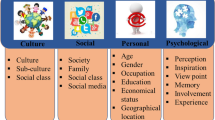Abstract
Recent research has reported that visual artwork used in advertisements or on product packaging affects perceptions of luxury and contributes positively to attitudes toward products. Thus, the use of visual artwork has been recommended to promote products. We investigated the effect of artwork on purchase intentions and identified a co-occurring negative effect via perceptions of expensiveness. Our research indicates that the sign of the overall effect of artwork depends on two moderators. The positive effect via perceptions of luxury exists only for hedonic products but not for utilitarian ones. The negative effect via perceptions of expensiveness only appears when information about the product’s price is not provided to the consumer. Based on our findings, we recommend using art only for hedonic products for which the prices are known.



Similar content being viewed by others
References
Amaldoss, W., & Jain, S. (2005). Conspicuous consumption and sophisticated thinking. Management Science, 51(10), 1449–1466.
Anderson, N. H. (1971). Integration theory and attitude change. Psychological Review, 78(3), 171–206.
Belke, B., Leder, H., Strobach, T., & Carbon, C. C. (2010). Cognitive fluency: high-level processing dynamics in art appreciation. Psychology of Aesthetics, Creativity, and the Arts, 4(4), 214–222.
Berlyne, D. E. (1974). Hedonic tone and reward value of exposure to paintings. In D. E. Berlyne (Ed.), Studies in the new experimental aesthetics: steps toward an objective psychology of aesthetic appreciation (pp. 227–233). Washington, D.C.: Hemisphere.
Bhat, S., & Reddy, S. K. (1998). Symbolic and functional positioning of brands. Journal of Consumer Marketing, 15(1), 32–43.
Dhar, R., & Wertenbroch, K. (2000). Consumer choice between hedonic and utilitarian goods. Journal of Marketing Research, 37(1), 60–71.
Hagtvedt, P., & Patrick, V. (2008). Art infusion: the influence of visual art on the perception and evaluation of consumer products. Journal of Marketing Research, 45(3), 379–389.
Higgins, E. T., Rholes, W. S., & Jones, C. R. (1977). Category accessibility and impression formation. Journal of Experimental Social Psychology, 13(2), 141–154.
Hirschman, E. C., & Holbrook, M. B. (1982). Hedonic consumption: emerging concepts, methods and propositions. Journal of Marketing, 46(3), 92–101.
Joy, A., & Sherry, J. F. (2003). Speaking of art as embodied imagination: a multisensory approach to understanding aesthetic experience. Journal of Consumer Research, 30(2), 259–282.
Lynn, M. (1989). Scarcity effects on desirability: mediated by assumed expensiveness. Journal of Economic Psychology, 19(2), 257–274.
Mandel, B. R. (2009). Art as an investment and conspicuous consumption good. American Economic Review, 99(4), 1653–1663.
Margolin, V. (1992). Product appeal and the aura of art. In S. Vihma (Ed.), Objects and images: studies in design and advertising (pp. 194–209). Helsinki: University of Industrial Arts.
Preacher, K. J., & Hayes, A. F. (2008). Asymptotic and resampling strategies for assessing and comparing indirect effects in multiple mediator models. Behavior Research Methods, 40(3), 879–891.
Slonim, R., & Garbarino, E. (1999). The effect of price history on demand as mediated by perceived price expensiveness. Journal of Business Research, 45(1), 1–14.
Strahilevitz, M. A., & Myers, J. G. (1998). Donations to charity as purchase incentives: how well they work may depend on what you are trying to sell. Journal of Consumer Research, 24(4), 434–446.
Tversky, A., & Kahneman, D. (1974). Judgment under uncertainty: heuristics and biases. Science, 185(4157), 1124–1131.
Venkatesh, A., & Meamber, L. A. (2006). Arts and aesthetics: marketing and cultural production. Marketing Theory, 6(11), 11–39.
Voss, K. E., Spangenberg, E. R., & Grohmann, B. (2003). Measuring the hedonic and utilitarian dimensions of consumer attitude. Journal of Marketing Research, 40(3), 295–309.
Yeung, C. W. M., & Wyer, R. S., Jr. (2004). Affect, appraisal, and consumer judgment. Journal of Consumer Research, 31(2), 412–424.
Zhao, X., Lynch, J. G., Jr., & Chen, Q. (2010). Reconsidering Baron and Kenny: myths and truths about mediation analysis. Journal of Consumer Research, 37(2), 197–206.
Acknowledgments
The authors wish to thank two anonymous reviewers and the responsible co-editor Frank R. Kardes for providing helpful comments. Additionally, we thank Florian F. Kottmair for assisting us in designing the test stimuli and for helping us with pretesting.
Author information
Authors and Affiliations
Corresponding author
Rights and permissions
About this article
Cite this article
Huettl, V., Gierl, H. Visual art in advertising: The effects of utilitarian vs. hedonic product positioning and price information. Mark Lett 23, 893–904 (2012). https://doi.org/10.1007/s11002-012-9196-z
Published:
Issue Date:
DOI: https://doi.org/10.1007/s11002-012-9196-z




